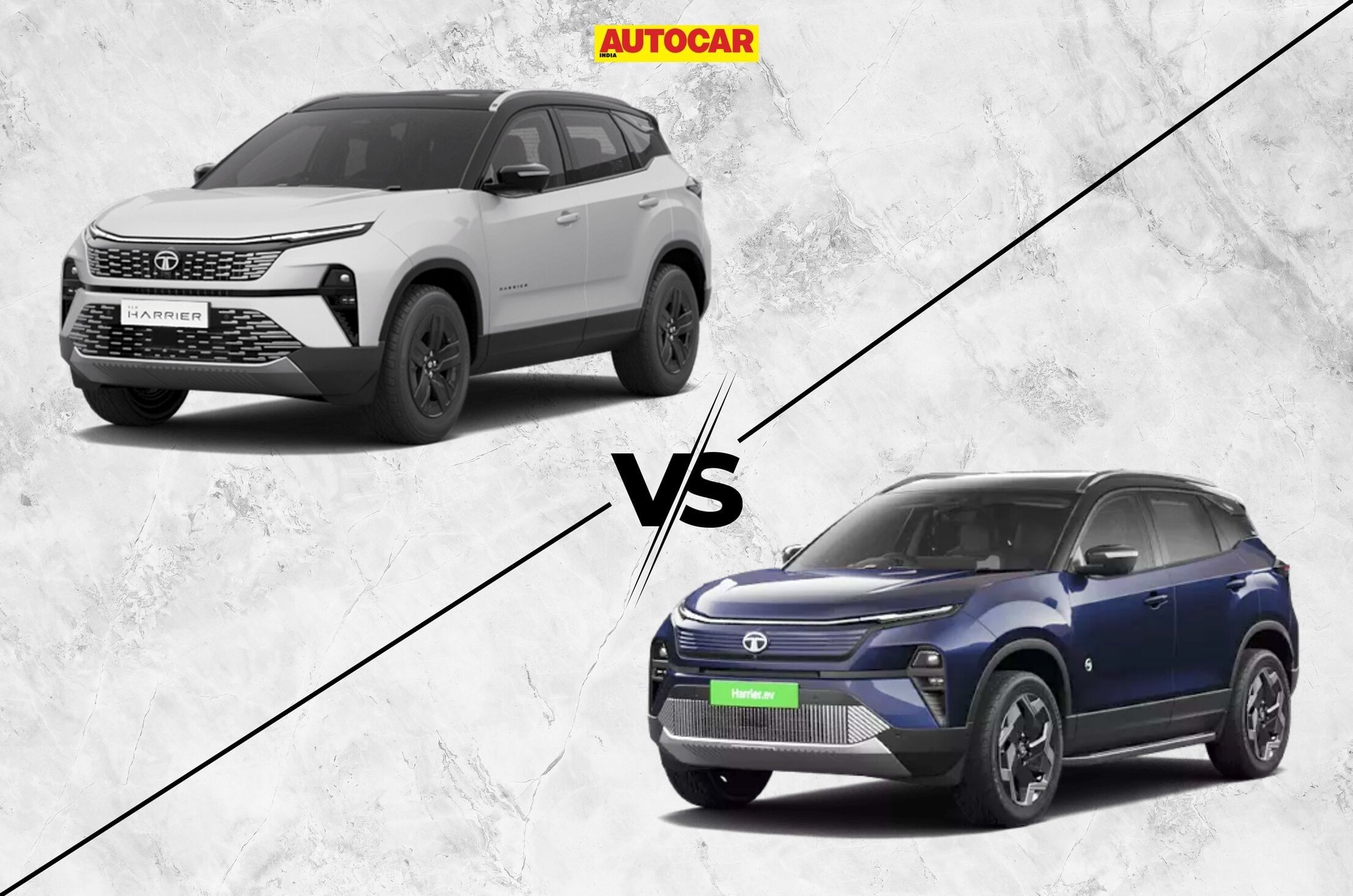
Tata Motors recently launched the Harrier EV as the carmaker’s most powerful, advanced, and feature-packed electric car to date. While the Harrier EV looks nearly identical to the diesel Harrier, both SUVs are very dissimilar under the skin and in terms of feature offerings. We’ve pored over the specs of the Harrier EV and Harrier diesel to see how Tata’s latest electric SUV differentiates itself.
Tata Harrier EV vs Harrier diesel exterior design
Harrier EV has subtle styling tweaks
On the outside, the differences between the Harrier EV and Harrier diesel are minimal. The Harrier EV gets unique styling flourishes like a closed-off grille, revised front bumper, silver bash plates, EV badging, and aero-friendly alloy wheels, but beyond these, there’s nothing that visually distinguishes it from the Harrier diesel. Most of the Harrier diesel’s design elements, like a butch, upright stance, blade-like connected LED daytime running lights, vertically-oriented headlight units, sharp rear light bar, and roof spoiler with integrated stop lamp have been carried forward to the Harrier EV.
Harrier diesel has nearly twice the colour options of Harrier EV
However, there’s a vast difference between the two SUVs when it comes to colour options. Across its entire variant portfolio, the Harrier diesel is offered with eight colours: Ash Grey, Coral Red, Lunar White, Matte Stealth Black, Oberon Black, Pebble Grey, Seaweed Green, and Sunlit Yellow. The Harrier EV nearly halves this list with five colour options, with most of them being unique finishes: Empowered Oxide, Nainital Nocturne, Matte Stealth Black, Pristine White, and Pure Grey.
Interestingly, the Harrier EV stretches the tape at 2mm longer and 22mm taller than the Harrier diesel, but their wheelbases are exactly the same at 2,741mm.
Tata Harrier EV vs Harrier diesel interior
Near-identical cabin layout
The Harrier EV’s cabin isn’t all that different from that of the Harrier diesel either. The general dashboard layout is largely shared between the two, including the four-spoke steering wheel with an illuminated Tata logo, 10.25-inch digital driver’s display, floating infotainment touchscreen, touch-based HVAC control panel, etc. However, the Harrier EV’s touchscreen is a larger 14.53-inch unit (12.3 inches for Harrier diesel) with a Samsung Neo QLED display, which Tata claims is a world-first feature.
Harrier EV IRVM is an all-digital unit that includes a dashcam
Additionally, the Harrier EV’s inside rearview mirror is fully digital unlike the conventional unit found in the Harrier diesel. Essentially a screen, the digital IRVM can show unobstructed views of both the front and rear of the Harrier EV, and even has an in-built dashcam with continuous front and rear recording.
Coming to boot space with the second row up, the Harrier EV stands at 502 litres (plus a frunk), while the Harrier diesel has a 445-litre cargo area. However, it’s worth noting that the Harrier diesel’s boot space is measured up to the parcel shelf, whereas the Harrier EV’s boot space is measured up to the roof.
Tata Harrier EV vs Harrier diesel features and safety
Harrier EV debuts brand-new electrical architecture
Tata has included a bevy of advanced functionality on the Harrier EV, courtesy of a new electrical architecture dubbed TiDAL (Tata Intelligent Digital Architecture Layer). This framework enables features like over-the-air updates, the infotainment system, 10-speaker JBL Black sound system, voice commands, 540-degree surround view function, Level 2 ADAS, and more. Speaking of the ADAS features, Tata claims that it has specifically calibrated them to work more effectively in unpredictable Indian road conditions.
Auto park and summon mode
On the safety front, the Harrier EV notably gets Off-road Assist over the Harrier diesel, which is essentially a low-speed cruise control (as low as 5kph) that allows the driver to focus on steering the SUV on off-road trails. The Harrier EV also features limited autonomous driving capabilities in the form of auto park assist and summon mode, which allows the SUV to extricate itself from tight spaces.
Harrier EV renders phones unnecessary for certain payments
Moreover, there’s a novel feature called DrivePay – a UPI-based in-car payment system that eschews the need for mobile devices to pay for FASTag, EV charging points, drive-throughs, and so on. Being an electric car, the Harrier EV is equipped with vehicle-to-load (V2L) and vehicle-to-vehicle (V2V) functionality too.
Other common creature comforts between the Harrier EV and Harrier diesel are a powered tailgate, panoramic sunroof, ventilated and powered front seats (driver’s seat gets memory function), dual-zone climate control, ambient lighting, cabin air purifier, wireless charger, fast-charging USB Type-C ports, rear sunshades, sliding armrest with cooled storage, and more. To enhance the experience for second row passengers, the Harrier EV additionally comes with a powered Boss mode, which automatically folds and moves the front passenger seat forward.
Tata Harrier EV vs Harrier diesel powertrain options
Harrier EV is built on a modified offshoot of diesel Harrier platform
The Harrier EV and Harrier diesel are expectedly poles apart in this area. Like its name suggests, the Harrier EV is an all-electric car that’s built on a heavily modified version of the Harrier diesel’s Omega platform – dubbed Acti.ev. The Harrier EV is available with two LFP battery pack options: 65kWh and 75kWh. The former is wired up to a single rear-mounted motor producing 238hp, while the latter adds a 158hp motor to the front axle, resulting in a combined 313hp and 504Nm output channeled to all four wheels. Four-level regenerative braking is also included, as well as a Drift mode
AWD and various off-road features available with Harrier EV
This means the 75kWh Harrier EV gets a feature that Tata cars haven’t offered in over five years: all-wheel drive. By contrast, the Harrier diesel is front-wheel drive only. Adding AWD has allowed Tata to place a greater emphasis on the Harrier EV’s off-road capabilities, with the SUV sporting a new multi-link rear suspension with frequency-dependent dampers, as well as six terrain modes (Harrier diesel has three): Normal, Snow/Grass, Mud-Ruts, Sand, Rock Crawl, Custom. There’s also a Transparent mode in the Harrier EV, which projects a live feed of what’s under the SUV to aid off-road traversal.
Harrier diesel develops 350Nm
Coming to the regular Harrier, it’s powered by a sole 2.0-litre turbo-diesel engine developing 170hp and 350Nm, which can be mated to either a 6-speed manual or 6-speed torque converter automatic gearbox. 0-100kph is in the 11-12 second region for the Harrier diesel, while the Harrier EV’s AWD 75kWh variant can sprint to 100kph from rest in just 6.3 seconds. The Harrier EV’s 0-100kph time is achieved with the help of Boost mode, which is one of four drive modes (Eco, City, Sport, Boost) available in the SUV’s AWD versions, while the RWD variants get the same three driving modes – Eco, City, Sport – as the Harrier diesel.
The Harrier EV delivers a 622km MIDC-certified range in AWD 75kWh guise, while the RWD 75kWh configuration can travel up to 627km on a single charge. Tata has yet to reveal range figures for the 65kWh version of the Harrier EV. In terms of charging, the Harrier EV can be juiced up from 10-100 percent in 10.7 hours with a 7.2kW AC charger, while a 120kW DC fast charger can provide a 20-80 percent charge in 25 minutes. Tata claims that a 15-minute fast charge nets 250km of range for the Harrier EV.
Tata Harrier EV vs Harrier diesel price and variants
16 Harrier trims available
The Harrier diesel has a wide repertoire of trim levels on offer, namely Smart, Smart(O), Pure, Pure(O), Pure+, Pure+ S, Pure+ S Dark Edition, Adventure, Adventure+, Adventure+ Dark Edition, Adventure+ A, Fearless, Fearless Dark Edition, Fearless+, Fearless+ Dark Edition, and Fearless+ Stealth Edition. Pricing for the Harrier diesel starts at Rs 15 lakh and tops off at Rs 26.50 lakh.
Full price list for Harrier EV yet to be revealed
By comparison, the Harrier EV has a far more distilled model portfolio, with only three variants to go on sale initially: Adventure, Fearless, and Empowered. So far, though, Tata has disclosed pricing only for the Harrier EV’s entry-level Adventure trim, which costs Rs 21.49 lakh (introductory). The top-spec Empowered trim of the Harrier EV will likely surpass the Harrier diesel in terms of pricing, and Tata is notably offering a lifetime battery warranty for the electric SUV.
All prices ex-showroom, India.
Also see:











